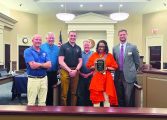By Page H. Gifford
Correspondent
Local playwright, Beth Sherk is creative when it comes to her plays but is also concerned with environmental issues. Both are combined in her play titled Ducky Dimsdale and the Sitting Ducks in Goldmine, an environmental fairy tale in the style of a live radio show. She describes her protagonist, Ducky, as the “good-hearted every-woman who just wants to live her small life and keep from going crazy from knowing too much.”
“But that’s a hard thing to do these days and trouble comes knocking in the form of a series of visitors with word of industrial gold mines and tales of disaster,” said Sherk. “It’s a presentation of the Mother Earth Medicine Show which is still mostly an idea in my head. I will say that Mother Earth is also a prominent character and is accompanied by live music as well. We do want to keep the ‘playful’ in play and bring a hopeful point of view in the face of such a dismal situation.”
“The play was written to help the Friends of Buckingham, a citizen organization working hard to alert people to the threat of industrial gold mining that is knocking at our door,” she said. “Like me, most folks don’t realize that from Fairfax to Halifax, Central Virginia is sitting on a huge deposit of gold-pyrite, (the Gold-Pyrite Belt), microscopic gold, embedded so deep that traditional mining methods couldn’t touch it.” Commercial gold mining ceased back in the 1940s in Virginia. The concern centers around Aston Bay, a mining company that is doing geological studies in Buckingham County.
“Now, with modern equipment, it becomes a lure to industrial mining operations that gouge enormous mile-wide pits, with shafts hundreds of feet down into an aquifer. But it is the cyanide laced wastewater that is the real threat. That’s how they separate the gold from the ore and, to my understanding, the runoff is somehow collected in huge lake-sized ‘holding ponds’ behind earthen dams. It’s all complex.”
She says the key to understanding the main issue is that the dams have a high failure rate.
“Examples from around the world, include the Brewer Mine in South Carolina. It collapsed in the 1990s, flooded the river with this toxic waste, and killed every living thing for 50 miles. The question we ask in the play is so when the dam bursts, what becomes of your groundwater?” Brewer Mine was mined from 1828-1995 and abandoned in 1999. It is currently a Superfund Site under the EPA. However, the problem with earthen dams is if they are seeping and if breached, they can have catastrophic consequences. This is why it is crucial that they must be maintained and controlled.
But it is the cyanide that concerns state officials looking into this. A rice-grain-sized dose of cyanide can be fatal, so imagine mines using several tons of cyanide per day. After the process, the cyanide-contaminated waste ore is usually just abandoned. To produce enough gold for a ring, 18 tons of waste ore are produced. A state task force called the Gold Mining Study Work Group has raised concerns regarding the environmental and social impacts of gold mining and its byproducts of mining known as tailings as well as the responsibility and management of these mined areas.
“We are at a pivotal point in our history in Central Virginia. If we act now to stop this before it begins, we can shift our story from a future disaster to a different track. Everything that matters comes from the earth but if we don’t protect it, we’re sabotaging the future,” said Sherk. “We have to be sensible. We can’t be wild alarmists. There are good reasons not to blindly react against every new attempt at progress. But while people may disagree about the clean energy vs oil-coal, industrial mining is a whole different beast.”
“There is plenty of gold supply.” The task force agrees and sees no benefit to mining gold. They will submit their report by the end of the year. “Then the question becomes do we want to risk poisoning our water supply so foreign companies can make their profits?”
The future is unknown but Sherk suggests looking at experience and what we would be facing if we allowed industrial mining into Central Virginia. “In a few short years after the Brewer Mine disaster, the company took off, leaving South Carolina with a super fund clean- up site to manage.”
She adds Buckingham residents are waking up to the threat they’re facing by signing on to the Prove it First Ordinance. The bill’s provisions include the right and responsibility of residents to make decisions locally to protect their communities and to protect themselves and their water, air, and land from toxic trespass, which would be a result of mining. There would also be a requirement for a metallic mining company to prove it first. The company would first have to provide proof of at least one metallic mine that did not cause harm. This ordinance was inspired by past Wisconsin and pending Minnesota laws.
“I see climate as the unifying issue of our day. I know it’s not simple and there are competing interests. Too often people get trapped in a false dichotomy of money vs. nature as if that is an equal choice,” she said. “Fear plays a huge part in people’s avoidance and denial. But in my opinion, being cautious is the conservative approach. We mustn’t forget that all it took was 4-5 days of torrential rains for that South Carolina dam to burst and it would be foolish not to take into account the disturbing weather patterns these days but there’s a distinct rise in dangerous storms and sooner than we want, that will become an unavoidable fact because sadly, you can’t argue with the wind.”




